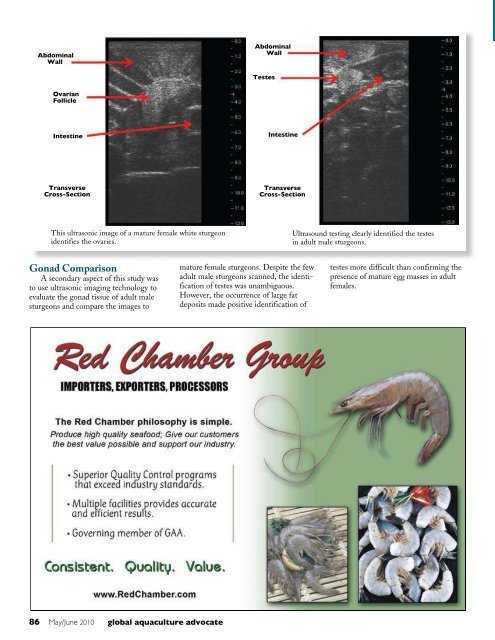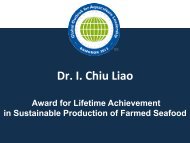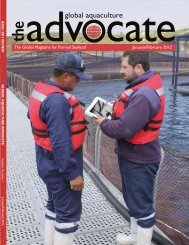May/June 2010 - Global Aquaculture Alliance
May/June 2010 - Global Aquaculture Alliance
May/June 2010 - Global Aquaculture Alliance
You also want an ePaper? Increase the reach of your titles
YUMPU automatically turns print PDFs into web optimized ePapers that Google loves.
Abdominal<br />
wall<br />
Ovarian<br />
Follicle<br />
Intestine<br />
Transverse<br />
Cross-Section<br />
This ultrasonic image of a mature female white sturgeon<br />
identifies the ovaries.<br />
Gonad Comparison<br />
A secondary aspect of this study was<br />
to use ultrasonic imaging technology to<br />
evaluate the gonad tissue of adult male<br />
sturgeons and compare the images to<br />
Abdominal<br />
wall<br />
Testes<br />
Intestine<br />
Transverse<br />
Cross-Section<br />
mature female sturgeons. Despite the few<br />
adult male sturgeons scanned, the identification<br />
of testes was unambiguous.<br />
However, the occurrence of large fat<br />
deposits made positive identification of<br />
Ultrasound testing clearly identified the testes<br />
in adult male sturgeons.<br />
testes more difficult than confirming the<br />
presence of mature egg masses in adult<br />
females.<br />
advocacy<br />
The True Cost Of Thai Shrimp<br />
Thailand’s conversion from black tiger production to raising healthy, fast-growing<br />
Pacific white shrimp increased efficiencies and reduced costs.<br />
Summary:<br />
Large volumes of shrimp continue to be exported into the United States at<br />
historically low prices. The reasons for this, however, are not about underpaid<br />
labor. The evolution of shrimp farming in Asia that included the conversion<br />
from black tiger shrimp to domesticated, disease-free white shrimp<br />
and practices that tightened biosecurity have led to greater efficiency and<br />
higher production that has outpaced demand.<br />
During the months of December<br />
2009 and January <strong>2010</strong>, cables news outlet<br />
CNN ran a report entitled “Slave<br />
Labor Blamed for Falling Shrimp Prices.”<br />
In this report, a shrimper from Louisiana,<br />
USA, stated: “We are trying to make a<br />
living, but because these foreign countries<br />
are using cheap labor, slave labor – call it<br />
whatever you want – we just can’t compete.<br />
Our biggest foe is cheap shrimp<br />
pouring in from Asia.”<br />
The report ends with the shrimper asking<br />
how Asia can produce so much shrimp<br />
so inexpensively. His answer: “Well, it can<br />
be done because you are not paying people<br />
or you are barely paying them.”<br />
The question of how shrimp can be<br />
exported into the United States at historically<br />
low prices is legitimate, but does<br />
the shrimper’s explanation reflect the true<br />
situation?<br />
Lamae Farm<br />
Consider the Lamae Farm, a shrimp<br />
farm owned and operated by Charoen<br />
Pokphand Foods (CPF) in the township<br />
of Lamae, Chumphon province, Thailand.<br />
This farm is neither large nor small<br />
by Thai standards, and is neither the best<br />
nor the worst of Thai farms. It represents<br />
a good farm about which to tell the story<br />
of the true cost of Thai shrimp.<br />
In 2002, the Lamae Farm grew black<br />
tiger prawns, as did 99% of all Thai farms<br />
that year. The farm was composed of six<br />
Robins McIntosh<br />
Senior Vice President<br />
Charoen Pokphand Foods Public Co.<br />
C.P. Tower 27 Floor<br />
313 Silom Road, Bangrak<br />
Bangkok, 10500, Thailand<br />
robmc101@yahoo.com<br />
ponds totaling 8.5 ha of culture area. The<br />
ponds were rectangular with earthen bottoms,<br />
and filled and drained through a<br />
canal system. Water for the farm was<br />
pumped directly from the Gulf of Thailand<br />
into a series of settling reservoirs.<br />
Production statistics for the farm are<br />
presented in Table 1. In 2002, the farm<br />
produced 11 successful harvests out of 12<br />
ponds stocked for a turn rate of 1.8<br />
cycles/year. The cost to produce 1 kg of<br />
60/kg shrimp was 174 baht (U.S. $4.35).<br />
The farm was profitable because the farm<br />
was able to sell its shrimp for 188 baht<br />
(U.S. $4.70)/kg (Table 2).<br />
In 2002, Lamae was a very successful<br />
farm by Thai standards. At that time, the<br />
annual pond failure rate in Thailand was<br />
over 10%. Average survival and growth<br />
rates had declined to less than 50% of<br />
what they were in 1995. With production<br />
trending in the wrong direction, costs<br />
were increasing.<br />
World production of shrimp in 2002<br />
was estimated at 1.3 mmt, with Thailand’s<br />
contribution of 250,000 mt produced<br />
from a pond area of 85,000 ha. But<br />
something was about to change in Thai<br />
shrimp farming: the introduction of new,<br />
more sustainable technologies.<br />
Sustainable Technologies<br />
The use of domesticated, disease-free<br />
shrimp and biosecure technologies was<br />
key to reversing the declining trend in the<br />
Thai shrimp industry. The domesticated<br />
Pacific white shrimp that came from the<br />
Americas allowed the creation of selective-breeding<br />
programs that further<br />
developed the shrimp for more and more<br />
efficient culture in the Asian systems and<br />
environment.<br />
In addition, the industry further<br />
adopted biosecure culture technologies<br />
for the exclusion of viruses from the pond<br />
environment. Farms were reconfigured to<br />
recycle water and use little if any exchange<br />
from open sources. Settling ponds were<br />
86 <strong>May</strong>/<strong>June</strong> <strong>2010</strong> global aquaculture advocate global aquaculture advocate <strong>May</strong>/<strong>June</strong> <strong>2010</strong> 87





